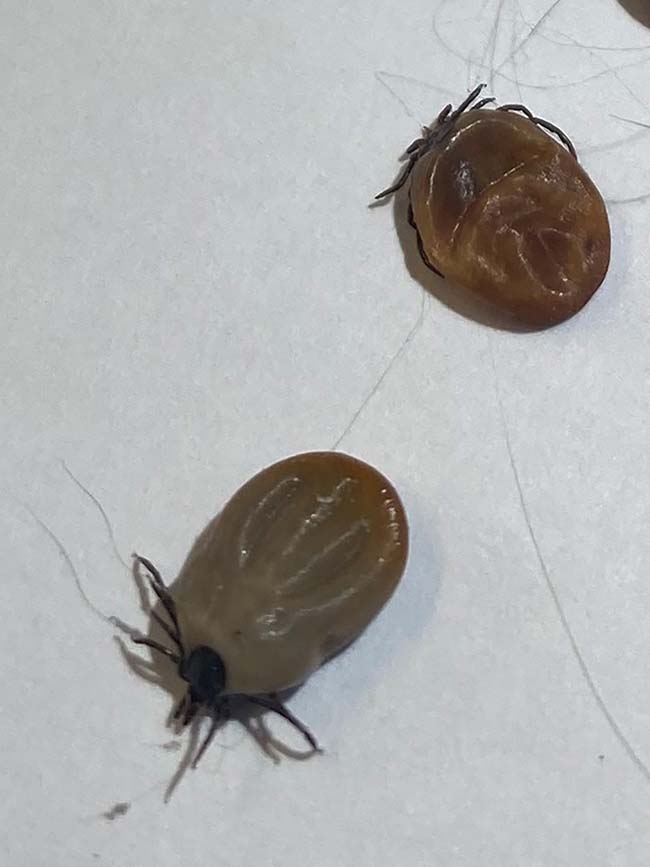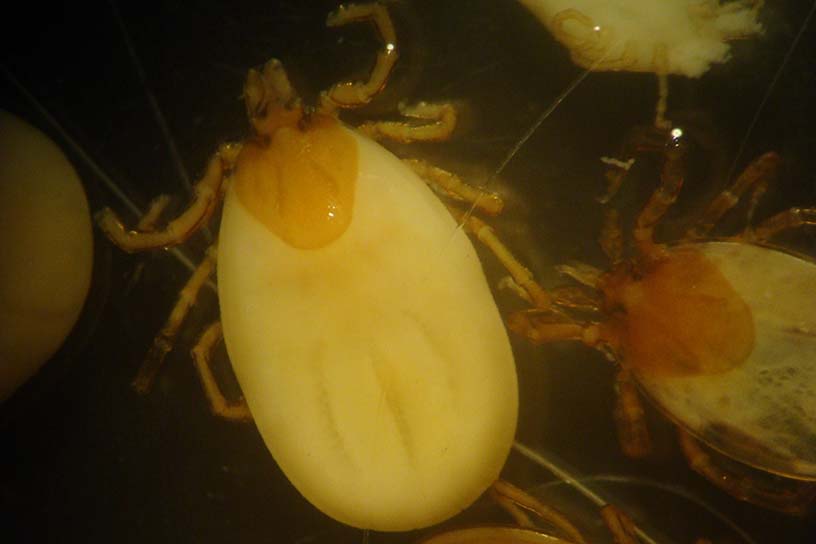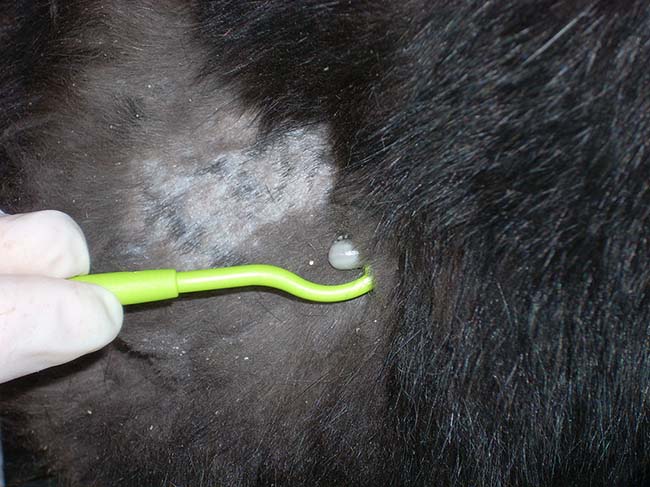14 Sept 2022
Getting year-round parasites message across to pet owners
Ian Wright discusses some of the important points members of vet teams can raise with clients about all-year risks.

Figure 2. Ixodes hexagonus. Image © John McGarry, University of Liverpool
While the need to treat some parasites, such as worms, is well accepted by many pet owners, others are perceived as having a seasonal nature. Ticks and fleas very much fit into this latter category. We have no evidence of a significant seasonal change in flea exposure in the UK, and although tick exposure does have a seasonal pattern, this is changing as the climate becomes warmer and wetter.
To a lesser extent, Angiostrongylus vasorum risk decreases in winter, but milder and wetter winters also allow slugs to become active for longer. We have an important role to play in alerting clients to changes in seasonal risk and that exposure risk is a year-round problem.
Some parasites of veterinary and zoonotic significance in the UK are unlikely to be perceived as seasonal.
Toxocara worms, for instance, are ubiquitous and transmitted primarily by transplacental and transmammary routes, and, as a result, shielded from environmental changes. Other worms, such as Taenia species tapeworms, are transmitted through the ingestion of meat and offal from domestic livestock or through hunting, with the intermediate host being largely unaffected by seasonal factors.
As a result, many pet owners have some familiarity with the concept of cats and dogs having worms, and exposure occurring throughout the year through routes such as hunting and scavenging.
Other parasites, however, are often perceived as seasonal. Both fleas and ticks depend heavily on warmth and humidity to reproduce, feed and survive, making seasonal fluctuations more likely. Angiostrongylus vasorum may also be considered as seasonal, as it relies primarily on slug exposure for transmission. Exposure to all of these parasites, however, can occur at any time of year, with disease in pets and people occurring as a result.
It is important that pet owners understand how these parasites are transmitted and why year-round protection is important for at-risk pets.
Fleas
Temperatures below freezing are lethal to adult fleas, with them dying within 5 days at -1°C and 10 days at 3°C. Survival significantly increases when temperatures exceed 8°C, where nearly half of emerged adults stay alive for 20 days (Silverman and Rust, 1983). Eggs and larvae are also highly susceptible to cold temperatures, with larvae dying 10 days post-hatching at 10°C (Silverman et al, 1981).
Therefore, the effects of cold temperatures in winter in many countries create a seasonal pattern for flea infestations. These effects are somewhat offset by the protection adult fleas are afforded by the fur of their host and, crucially, by centrally heated homes – making infestations sustainable all year round.
Milder winter temperatures, such as those seen lately in the UK, mean outdoor life stages can also continue to survive and develop. This means as a trend of overall milder seasons continues, it can be expected flea infestations on domestic pets – and subsequent household infestations – will not show marked seasonal fluctuations.
Even where seasonal fluctuations in exposure do occur, they would have to be significant enough to prevent infestations establishing over time for year-round flea treatment not to be required, and no evidence shows this is currently the case.
Household infestations may establish through the winter through the mechanical transmission of newly emerged adults into the home. Even households with purely indoor cats may be infested by owners triggering outdoor pupal emergence through their heat and movement – and then bringing newly emerged adults inside on clothing. Once inside, these adults can feed on indoor cats and infestation can be established.
In a similar fashion, cats visiting multiple households may be infested by newly emerged adults outdoors and then bring them indoors into a number of different homes.
Year-round prevention is, therefore, required, as a high risk of flea infestations establishing exists without it (Coles and Dryden, 2014), and cat fleas are present across the UK (Abdullah et al, 2019). Prevention is essential to prevent owner irritation, flea allergic dermatitis in pets and the risk of zoonotic pathogen exposure in owners, including of Bartonella henselae and Rickettsia felis.
Pet owners may not be aware of this year-round risk and veterinary practices have a vital role to play – both in conveying this message, but also in ensuring an appropriate flea product is selected to suit a pet’s lifestyle and maximise owner compliance.
To effectively prevent flea reproduction, a flea adulticide product must:
- Kill fleas quickly enough to prevent egg laying – 100 per cent efficacy is not sufficient if the fleas are able to reproduce before they are killed. Adult fleas can lay eggs within 24 hours, so effective adulticides must kill fleas at least within that time.
- Be applied often enough to continue to prevent egg laying. The time after application when fleas survive long enough in the presence of the product to lay eggs is known as the “reproductive break point”. If the reproductive break point is reached, then flea control will fail.
Factors to be considered when selecting a flea prevention product include:
- Does the owner shampoo the pet or does the pet regularly swim? The efficacy of compounds that are absorbed in the sebum layer, such as fipronil and imidacloprid, will be affected by sebum-stripping shampoos, and may also be affected by frequent swimming. Loss of product from pets in this way may also lead to environmental contamination.
- Does the owner prefer a tablet, spot-on preparation or collar? Some pets may have a history of skin reactions or vomiting after previous administration of parasite control products. The owner may also feel more able to apply some forms of medication than others. Applying a product in the surgery to maximise efficacy may be required where all forms of treatment are difficult for the owner to apply.
- What other parasite prevention is required? Endectocides or products containing more than one parasiticide may be beneficial to improve compliance if prevention against other parasites – such as roundworm, tapeworm, ticks or lungworm – is required. Equally, a monovalent product should be used if only continual flea prevention is required.
Ixodes species ticks
Ixodes species are the most common ticks in the UK and transmit Borrelia burgdorferi – the cause of Lyme disease – as well as a range of other pathogens, including Anaplasma phagocytophilum and tick-borne encephalitis virus (TBEV). Dogs, cats and humans across the country are at risk of exposure to infection via infected Ixodes species ticks, such as Ixodes ricinus (Figure 1) and Ixodes hexagonus (Figure 2).


Two large studies in the past decade have examined the distribution and prevalence of these ticks infesting domestic dogs, as well as the prevalence of B burgdorferi in these ticks (Smith et al 2012; Abdullah et al, 2016).
Prevalence of Borrelia species found in Ixodes ticks attached to dogs has only increased marginally from 2.3 per cent to 2.37 per cent in the time between the two aforementioned studies, but the overall number of ticks has increased.
Historically, the risk of exposure could be considered to be seasonal, with ticks typically ceasing activity below 4°C, and with recognised peaks of activity in the spring and autumn. These peaks were still present during the time of the Smith study, but even then increased summer activity was becoming more evident (Smith et al, 2011).
Real-time data from the latest tick surveillance scheme, however, suggests an extended peak of increased activity now occurs more uniformly from early spring through until late autumn, with exposure potentially occurring at any time of year (Wright et al, 2018). Recognising an increased risk of exposure throughout the spring, summer and autumn months – with the potential for exposure at any time of year – is important to help in preventing tick and tick-borne pathogen exposure. The need for tick prevention should be, therefore, considered all year and be based on lifestyle and geographic risk factors.
Several factors should be considered:
- Are dogs walked on pasture shared by ruminants or deer? Deer and ruminants are reproductive reservoirs for Ixodes ticks – especially I ricinus – with the potential for individual animals to carry very large numbers of ticks.
- Do dogs walk on land containing tall grass or bracken? This provides tick questing sites.
- Do cats and dogs visit known geographic areas of high tick density? Certain areas of the UK have been demonstrated to have high tick densities, including the New Forest, Yorkshire Dales, Lake District and Scottish Highlands. The previous Big Tick Project looking at the prevalence of ticks on pet dogs confirmed these patterns, although discrepancies such as the apparent absence of ticks from parts of the Scottish Highlands could be explained by the lack of participating veterinary practices in these areas.
The recording and publicising of ticks found in practice, via websites and social media, is useful to help pet owners and veterinary practices assess local geographic risk. The tick surveillance scheme also records geographic data from where ticks are submitted (Wright et al, 2018).
- Do cats roam freely or hunt? Such activity is more likely to lead them into undergrowth, burrows or nests containing ticks.
- Do dogs live in or visit Thetford Forest or the New Forest? Those that do should be considered at increased risk of TBEV exposure.
- Do cats and dogs have a history of tick exposure? An infestation history implies a lifestyle that would put them at risk of further exposure in the future.
- Have pets been imported or travelled abroad? These pets should be treated and checked for ticks to reduce the risk of exotic tick introduction.
If after risk assessment it is decided preventive tick treatment should be employed, this should consist of a preventive product and checking for ticks after outdoor activity:
- Preventive tick treatments: the use of prophylactic compounds that rapidly kill or repel ticks are useful in reducing tick feeding, and, therefore, transmission of infection. Products containing an isoxazoline or pyrethroid all fulfil these criteria. With the exception of flumethrin, pyrethroid products must never be used on cats due to resultant toxicity.
- Checking for ticks at least every 24 hours: this is essential in high-risk pets and those that have travelled abroad, as no tick preventive product is 100 per cent effective and challenge in some geographical foci can be very high.
Latest tick surveillance scheme data suggests that the majority of ticks are located and found around the head, face, legs and ventrum (Wright et al, 2018). Ticks should be removed with a tick removal device (Figure 3).

A vasorum
A vasorum has been spreading north throughout the UK over the past 20 years. Postmortem surveys were carried out on foxes in 2005 (Morgan et al, 2008) and in 2014 (Taylor et al, 2015), which act as wildlife reservoirs.
The overall prevalence rose from 7 per cent to 18 per cent in foxes during this period and extended to regions previously clear of infection, such as northern England and Scotland. This is thought to be due to the movement of infected dogs around the country leading to reservoir fox and slug populations being exposed.
Dog exposure to the parasite is through consumption of infected slugs, snails and paratenic hosts, such as frogs. Some pet owners may feel, therefore, that the exposure to the parasite is seasonal, with slugs being more active in the spring and summer.
The climate in the UK of late has favoured the survival and propagation of arionid slugs, which dominate in terms of both prevalence and intensity of A vasorum infection.
A wetter, milder climate increases their activity, with the likelihood that they will be eaten. Smaller slug species are also infected, and while they carry a smaller number of the total parasite population, their small size increases the likelihood of accidental ingestion by dogs (Aziz et al, 2016). Both types of slugs remain active all year round, with milder and warmer winters increasing their activity. This means dogs may be exposed to A vasorum at any time of year.
Dogs at high risk of exposure should, therefore, be placed on a year-round licensed routine preventive treatment. These include previously infected dogs, any dogs living in close proximity to other cases and those that are coprophagic or eating slugs, snails, grass and amphibians.
Geographic risk is based on local knowledge and national mapping. In areas where endemic status is less certain, testing of dogs prior to surgery or when cases are suspected – for example, due to coughing or unexplained coagulopathies – will allow a picture of whether A vasorum is endemic in an area to be built up. This will also indicate whether routine prophylaxis for dogs in the area is required. This data accumulation is vital if risk-based advice is going to be given.
Screening suspected cases has been made easier by a point-of-care blood test that detects circulating A vasorum antigen in the blood. It has a reported sensitivity of 84.6 per cent and specificity of 100 per cent (Schnyder et al, 2014). The AngioDetect test (Idexx Laboratories, US) allows for more rapid diagnosis in a clinical setting, and also allows many dogs with clinical signs compatible with A vasorum infection to be tested relatively economically and rapidly.
This, in turn, allows a picture within practices to be built up as to whether A vasorum is present in the local area. This picture needs to constantly be updated, however, as the regional prevalence of A vasorum can be very fluid.
Conclusions
A mild, humid climate in the UK is beneficial for many parasites to feed, reproduce and increase their geographical distribution. This means that even parasites with previously recognised seasonal activity, such as Ixodes ticks, are blurring that pattern.
Spring, summer and autumn provide clear increased risk of tick exposure, but care should be taken by veterinary professionals when taking seasonality into account as part of a parasite risk assessment for individual pets. Some perceptions about seasonality, such as exposure to A vasorum, have no basis in current evidence and year-round protection is essential for year-round dogs.
These messages can be conveyed to clients through vet consults, nurse clinics, social media platforms and waiting room posters. In doing so it can be ensured pets are protected all year from parasites posing a risk to them.
